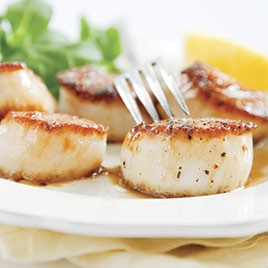Pan-Seared Scallops

Producing, crisp-crusted restaurant-style scallops means overcoming two obstacles: chemically treated scallops and weak stovetops. We wanted to achieve superior pan-seared scallops that had a perfectly brown crust and no hint of off-flavors.
We decided to work with wet scallops (those that are chemically treated with STP, a solution of water and sodium tripolyphosphate, to increase shelf life and retain moisture) first. If we could develop a good recipe for finicky wet scallops, it would surely work with premium dry (untreated) scallops. We found that waiting to add the scallops to the skillet until the oil was beginning to smoke, cooking the scallops in two batches instead of one, and switching to a nonstick skillet (so that the browned bits formed a crust on the meat instead of sticking to the skillet) were all steps in the right direction. But it wasn’t until we tried a common restaurant technique—butter basting—that our scallops really improved. We seared the scallops in oil on one side and added butter to the skillet after flipping them. (Butter contains milk proteins and sugars that brown rapidly when heated.) We then used a large spoon to ladle the foaming butter over the scallops. Waiting to add the butter ensured that it had just enough time to work its browning magic on the scallops, but not enough time to burn.
Next we addressed the lingering flavor of STP. Unable to rinse it away, we decided to mask it by soaking the scallops in a saltwater brine containing lemon juice. For dry scallops, we simply skipped the soaking step and proceeded with the recipe. It produced scallops that rivaled those made on a powerful restaurant range, with golden brown exteriors and juicy and tender interiors.
We strongly recommend purchasing “dry” scallops (those without chemical additives). If you can only find “wet” scallops, soak them in a solution of 1 quart cold water, 1/4 cup lemon juice, and 2 tablespoons table salt for 30 minutes before proceeding with step 1. In step 2, season the scallops with pepper only. If you are unsure whether your scallops are wet or dry, conduct this quick test: Place 1 scallop on a paper towel-lined, microwave-safe plate and microwave on high power for 15 seconds. If the scallop is “dry,” it will exude very little water. If it is “wet,” there will be a sizable ring of moisture on the paper towel. (The microwaved scallop can be cooked as is.) Prepare the sauce (if serving) while the scallops dry (between steps 1 and 2) and keep it warm while cooking them. For an accompaniment, use one of our recipes for Orange-Lime Vinaigrette, Ginger Butter Sauce, and Caper-Mustard Sauce.
1 1/2 pounds dry sea scallop, 10 to 20 per pound, small side muscles removed
Table salt and ground black pepper
2 tablespoons vegetable oil
2 tablespoons unsalted butter
Lemon wedges or sauce for serving
1. Place scallops on rimmed baking sheet lined with clean kitchen towel. Place second clean kitchen towel on top of scallops and press gently on towel to blot liquid. Let scallops sit at room temperature 10 minutes while towels absorb moisture.
2. Sprinkle scallops on both sides with salt and pepper. Heat 1 tablespoon oil in 12-inch nonstick skillet over high heat until just smoking. Add half of scallops in single layer, flat-side down, and cook, without moving, until well browned, 1 1/2 to 2 minutes.
3. Add 1 tablespoon butter to skillet. Using tongs, flip scallops; continue to cook, using large spoon to baste scallops with melted butter (tilt skillet so butter runs to one side) until sides of scallops are firm and centers are opaque, 30 to 90 seconds longer (remove smaller scallops as they finish cooking). Transfer scallops to large plate and tent loosely with foil. Wipe out skillet with wad of paper towels and repeat cooking with remaining oil, scallops, and butter. Serve immediately with lemon wedges or sauce.
None Available.